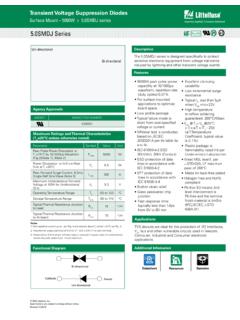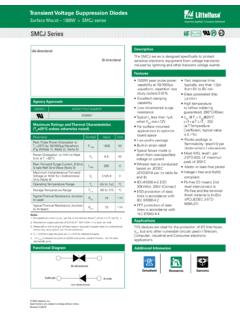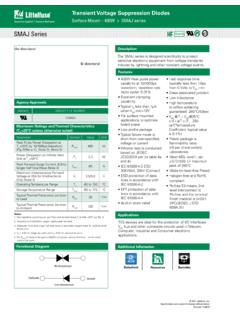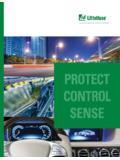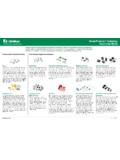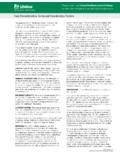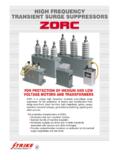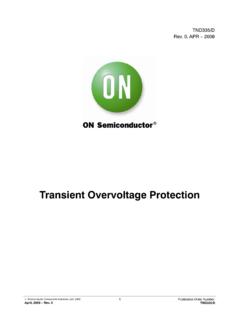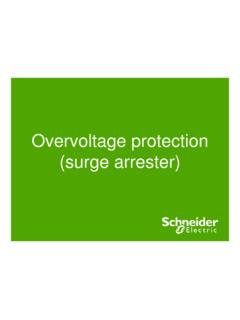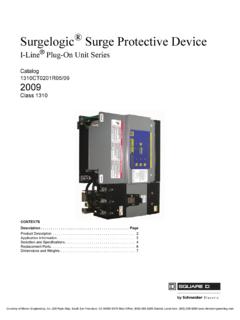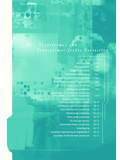Transcription of Transient Suppression Devices and Principles - …
1 Transient Suppression Devices and Principles Application Note January 1998 AN9768. Transient Suppression Devices Z = 1 . 1000. There are two major categories of Transient suppressors: a). those that attenuate transients, thus preventing their NONLINEAR Z ( = 5). propagation into the sensitive circuit; and b) those that divert 0 . Z = 50. E. transients away from sensitive loads and so limit the residual 100. C. VOLTAGE (V). N. DA. Z = 10 . voltages. PE. IM. R. Attenuating a Transient , that is, keeping it from propagating EA. 10. N. away from its source or keeping it from impinging on a LI. 1 . sensitive load is accomplished with filters inserted in series =. Z. within a circuit. The filter, generally of the low-pass type, attenuates the Transient (high frequency) and allows the signal 1.
2 1 10 100 1000. or power flow (low-frequency) to continue undisturbed. CURRENT (A). V. Diverting a Transient can be accomplished with a LINEAR IMPEDANCE: I =. R. voltage-clamping type device or with a crowbar type NONLINEAR IMPEDANCE (POWER LAW): I = KV. device. The designs of these two types, as well as their operation and application, are different enough to warrant a FIGURE 1. VOLTAGE/CURRENT CHARACTERISTIC FOR A. brief discussion of each in general terms. A more detailed LINEAR 1 RESISTOR AND NONLINEAR. description will follow later in this section. A voltage-clamping device is a component having a variable ZS. impedance depending on the current flowing through the device or on the voltage across its terminal. These Devices exhibit a nonlinear impedance characteristic that is, Ohm's law is applicable but the equation has a variable R.
3 The ZV. VOC ZV. variation of the impedance is monotonic; in other words, it V ZV = ---------------------- ZV + ZS. V OC. does not contain discontinuities in contrast to the crowbar device, which exhibits a turn-on action. The volt-ampere characteristic of these clamping Devices is somewhat time-dependent, but they do not involve a time delay as do the sparkover of a gap or the triggering of a thyristor. FIGURE 2A. VOLTAGE CLAMPING DEVICE. With a voltage-clamping device, the circuit is essentially unaffected by the presence of the device before and after the ZS. Transient for any steady-state voltage below the clamping level. The voltage clamping action results from the increased Z1. current drawn through the device as the voltage tends to SCR. rise. If this current increase is greater than the voltage rise, VOC VZV.
4 The impedance of the device is nonlinear (Figure 1). The apparent clamping of the voltage results from the R1. increased voltage drop (IR) in the source impedance due to the increased current. It should be clearly understood that the device depends on the source impedance to produce the FIGURE 2B. CROWBAR DEVICE. clamping. One is seeing a voltage divider action at work, where the ratio of the divider is not constant but changes. FIGURE 2. DIVISION OF VOLTAGE WITH VARIABLE. IMPEDANCE SUPPRESSOR. However, if the source impedance is very low, then the ratio is low. The suppressor cannot be effective with zero source impedance (Figure 2) and works best when the voltage divider action can be implemented. 10-102 1-800-999-9445 or 1-847-824-1188 | Copyright Littelfuse, Inc. 1998. Application Note 9768.
5 Crowbar-type Devices involve a switching action, either the A Simplified Comparison Between breakdown of a gas between electrodes or the turn-on of a Protection with Linear and Nonlinear thyristor, for example. After switching on, they offer a very low impedance path which diverts the Transient away from Suppressor Devices the parallel-connected load. Assume an open-circuit voltage of 3000V (see Figure 2): These types of crowbar Devices can have two limitations. 1. If the source impedance is ZS = 50 . One is delay time, which could leave the load unprotected With a suppressor impedance of ZV = 8 . The expected current is: during the initial Transient rise. The second is that a power current from the voltage source will follow the surge 3000. 1 = ---------------- = A and V R = 8 = 414V.
6 Discharge (called follow-current or power-follow ). In AC 50 + 8. circuits, this power-follow current may not be cleared at a The maximum voltage appearing across the terminals of a natural current zero unless the device is designed to do so; typical nonlinear V130LA20A varistor at is 330V. in DC circuits the clearing is even more uncertain. In some cases, additional means must be provided to open the Note that: crowbar. Z S I = 50 = 2586V. Z V I = 8 = 414V. Filters = 3000V. The frequency components of a Transient are several orders of magnitude above the power frequency of an AC circuit 2. If the source impedance is only 5 (a 10:1 error in the as- and, of course, a DC circuit. Therefore, an obvious solution is sumption), the voltage across the same linear 8 sup- to install a low-pass filter between the source of transients pressor is: and the sensitive load.
7 8. V R = 3000 ------------- = 1850V. 5+8. The simplest form of filter is a capacitor placed across the line. The impedance of the capacitor forms a voltage divider However, the nonlinear varistor has a much lower with the source impedance, resulting in attenuation of the impedance; again, by iteration from the characteristic curve, Transient at high frequencies. This simple approach may try 400V at 500A, which is correct for the V130LA20A; to have undesirable side effects, such as a) unwanted prove the correctness of our educated guess we resonances with inductive components located elsewhere in calculate I, the circuit leading to high peak voltages; b) high inrush currents during switching, or, c) excessive reactive load on 3000-400V ZS x I = 5 x 520 = 2600V. I= = 520A VC = 400V.
8 The power system voltage. These undesirable effects can be 5. = 3000V. reduced by adding a series resistor hence, the very popular use of RC snubbers and Suppression networks. However, which justifies the educated guess of 500A in the circuit. the price of the added resistance is less effective clamping. Summary Beyond the simple RC network, conventional filters comprising inductances and capacitors are widely used for TABLE 1. 3000V OPEN-CIRCUIT Transient VOLTAGE. interference protection. As a bonus, they also offer an ASSUMED SOURCE IMPEDANCE. effective Transient protection, provided that the filter's front- 50 5 . end components can withstand the high voltage associated with the Transient . PROTECTIVE DEVICE PROTECTIVE LEVEL ACHIEVED. There is a fundamental limitation in the use of capacitors Linear 8 414V 1850V.
9 And filters for Transient protection when the source of Nonlinear Varistor 330V 400V. transients in unknown. The capacitor response is indeed nonlinear with frequency, but it is still a linear function Similar calculations can be made, with similar conclusions, of current. for an assumed error in open-circuit voltage at a fixed source impedance. In that case, the linear device is even more To design a protection scheme against random transients, sensitive to an error in the assumption. The calculations are it is often necessary to make an assumption about the left for the interested reader to work out. characteristics of the impinging Transient . If an error in the source impedance or in the open-circuit voltage is made in The example calculated in the simplified comparison that assumption, the consequences for a linear suppressor between protection with linear and nonlinear Suppression and a nonlinear suppressor are dramatically different as Devices shows that a source impedance change from an demonstrated by the following comparison.
10 Assumed 50 to 5 can produce a change of about 414V to 1850V for the protective voltage of a typical linear suppressor. With a typical nonlinear suppressor, the 10-103. Application Note 9768. corresponding change is only 330V to 400V. In other words, Zener Diodes - Silicon rectifier technology, designed for a variation of only 21% in the protective level achieved with a Transient Suppression , has improved the performance of nonlinear suppressor occurs for a 10 to 1 error in the regulator-type Zener diodes. The major advantage of these assumption made on the Transient parameters, in contrast to diodes is their very effective clamping, which comes closest a 447% variation in the protective level with a linear to an ideal constant voltage clamp. suppressor for the same error in assumption.
